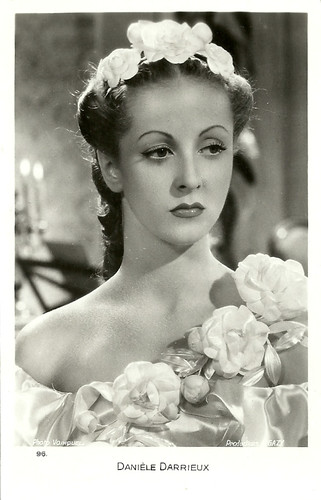
French postcard. Photo: Raymond Voinquel / Production Gazy. Danielle Darrieux as Marie Vetsera in Mayerling (Anatole Litvak, 1936).

German postcard by Ross Verlag, no. 567. Photo: Ufa. Lilian Harvey in Nie wieder Liebe! (Anatole Litvak, 1931).
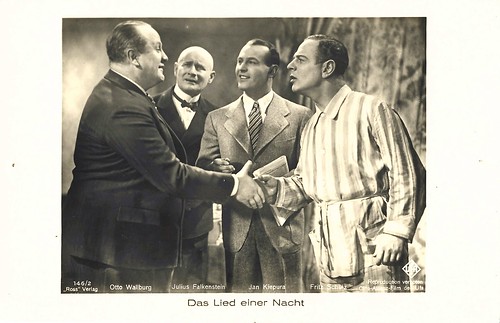
German postcard by Ross Verlag, no. 146/2. Photo: Cine-Allianz-Film der Ufa. Otto Wallburg, Julius Falkenstein, Jan Kiepura and Fritz Schulz in Das Lied einer Nacht/The Song of Night (Anatole Litvak, 1932).

French postcard by Erpé, no. 628. Photo: Film Pathé Natan. Jean-Pierre Aumont in L'équipage/Flight Into Darkness (Anatole Litvak, 1935).

British postcard in the Film Partners Series, London, no. PC 251. Photo: Warner. Charles Boyer and Claudette Colbert in Tovarich (Anatole Litvak, 1937).
Witness of the 1917 Russian Revolution
Anatoly Mikhailovich Litvak was born in 1902 in the city of Kyiv in the Russian Empire (now Ukraine). He was the son of Lithuanian Jewish parents. "Litvak" means "Lithuanian" in Yiddish.
The family moved to St. Petersburg, the capital of the Russian Empire. In 1915, Antatoly began to work at a little-known experimental theatre.
As a teenager, he witnessed the 1917 Russian Revolution and the consequent nationalisation of all theatres and drama schools.
In St. Petersburg, he studied philosophy at the university but in 1921 he began to train as an actor and theatre director in the same city. In 1923, he started working as a set decorator and assistant director for Nordkino Studios in Leningrad (the Soviet name for St. Petersburg).
Litvak worked his way up to directing short features, notably Tatiana (Anatole Litvak, 1925), a film about children.
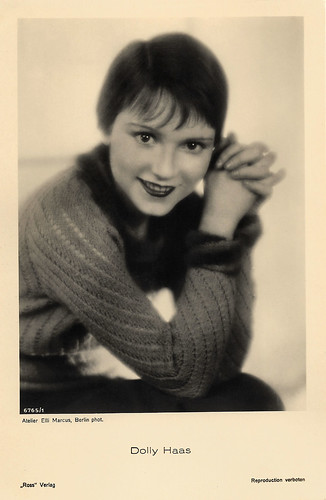
German postcard by Ross Verlag, no. 6765/1, 1931-1932. Photo: Atelier Elli Marcus, Berlin. Dolly Haas in Dolly macht Karriere/Dolly's Way to Stardom (Anatole Litvak, 1930).
Litvak's first European feature, Dolly macht Karriere/Dolly's Way to Stardom, was a musical vehicle for up-and-coming Dolly Haas. She plays a would-be actress with a would-be composer boyfriend. At one point, she sings that she has the walk of Lilian Harvey, the mouth of Greta Garbo and the legs of Marlene Dietrich.

German collectors card in the series 'Vom Werden deutscher Filmkunst - Der Tonfilm', album no. 11, picture no. 61. Photo: Ufa / Ross Verlag. Lilian Harvey and Harry Liedtke in Nie wieder Liebe!/No More Love (Anatole Litvak, 1931).
Harry Liedtke in Nie wieder Liebe!/No More Love is an American millionaire, who always has bad luck with women. He bets that he can live without them for five years. But after four and a half years travelling around on his yacht, he rescues a lady, Lilian Harvey, in her one piece and bathing cap, from the English Channel. Litvak's undistinguished second European feature comes in a couple of languages and uses montage and moving camera to try to disguise the thinness of its script. However, Harvey - at the peak of her career, makes a lively impression.
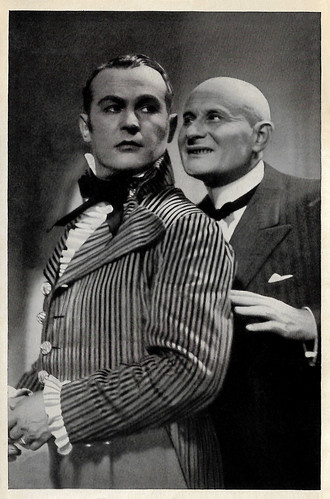
German collectors card in the series 'Vom Werden deutscher Filmkunst - Der Tonfilm', album no. 11, picture no. 32. Photo: Cine-Allianz / Ross Verlag. Jan Kiepura and Julius Falkenstein in Das Lied einer Nacht/The Song of Night (Anatole Litvak, 1932).
In Das Lied einer Nacht/The Song of Night, Opera star Enrico Ferraro (Polish tenor Jan Kiepura), tired of his stressful schedule, changes trains for a Swiss vacation. When his presence is discovered at the peaceful lakeside resort, he changes places with a new friend (Fritz Schulz) pretending he is his secretary. Free at last he explores the country and meets a beautiful girl (Magda Schneider). In this German musical, Litvak is already tracking, panning and quick cutting to push up the pace of his work. He also directed a now-lost English version, Tell Me Tonight (1932), and a French version, La chanson d'une nuit (1932), both also with Kiepura.
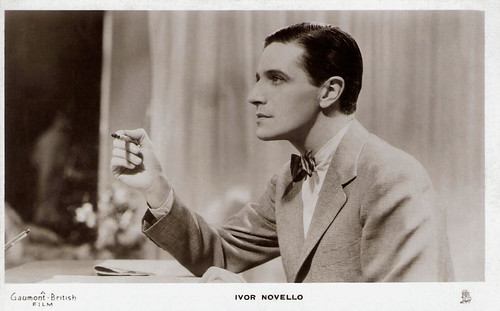
British postcard by Raphael Tuck & Sons, London, no. 50-S. Photo: Gaumont-British. Ivor Novello in Love and Let Love/Sleeping Car (Anatole Litvak, 1933).
In the charming romantic comedy Love and Let Love/Sleeping Car, Ivor Novello plays a French sleeping car attendant with a girl at every stop of the Orient Express. He hooks up with a wealthy widow (Madeleine Carroll) to add her to his collection. Being a good iceberg blonde, she resists. However, when she is given two weeks to get out of France for having too many speeding tickets, she decides to take advantage of a loophole by marrying a Frenchman. Novello gets the job but insists there be no funny business. The stars are very good and seem to be having a good time.
A major hit on both sides of the Atlantic
In 1925, Antole Litvak left the Soviet Union for Berlin to find more artistic possibilities. He was hired by the renowned director Georg Wilhelm Pabst to edit Die freudlose Gasse/The Joyless Street (G.W. Pabst, 1925) starring Asta Nielsen and Greta Garbo.
In 1930, he began directing numerous short films for Ufa. His first full-length feature was the romantic comedy Dolly macht Karriere/Dolly's Way to Stardom (Anatole Litvak, 1930) starring Dolly Haas.
Litvak's stay in Germany was cut short by the rise to power of Adolf Hitler. The Jewish Litvak moved to France and directed four films, including the historical drama Mayerling (Anatole Litvak, 1936), starring Charles Boyer and Danielle Darrieux.
This production was the turning point in Litvak's career, being a major hit on both sides of the Atlantic. He received effusive praise from critic Frank S. Nugent of the New York Times, who commented on the director's "superb assembling of scenes" and the "matchless performances" of the stars (September 14,1937). Hollywood soon beckoned and Litvak signed with RKO. After a year at RKO, he transferred to Warner Bros.
From 1937 to 1941, Litvak was a contract director for Warner Brothers. His first film was The Woman I Love (Anatole Litvak, 1937), which starred his future wife Miriam Hopkins. His experience with diverse aspects of stagecraft, as well as his fluency in four languages (Russian, German, French and English), enabled him to competently tackle a wide variety of subjects. The screwball comedy Tovarich (Anatole Litvak, 1937)) was a film adaptation of a Broadway hit starring Claudette Colbert and Charles Boyer. It paved the way for Litvak's further career.

Dutch postcard. Photo: Filmex, Amsterdam. Madeleine Guitty and Harry Baur in Cette vieille canaille/The Old Devil (Anatole Litvak, 1933).
Harry Baur stars in one of Litvak's first French films, Cette vieille canaille/The Old Devil, as Vautier, a wealthy surgeon in his fifties. He falls in love with Hélène (Alice Field), a young woman from a modest background. He allows her to have a string of short-lived lovers - but when Jean Trapeau, an old boyfriend (Pierre Blanchar), resurfaces, things get complicated.

French postcard, no. 79. Jean-Pierre Aumont in L'équipage/Flight into Darkness (Anatole Litvak, 1935).
In L'équipage/Flight into Darkness (Anatole Litvak, 1935), Charles Vanel and Annabella star as a daring WW I aviator and his loving but neglected wife. Ostracised by the other pilots because of his recklessness and standoffishness, Vanel nonetheless befriends a young pilot (Jean-Pierre Aumont) who is in love with Vanel's wife. Litvak did a couple of years later an American version, The Woman I Love (Anatole Litvak, 1937) with Paul Muni and Miriam Hopkins, but L'équipage is the better of the two thanks to the excellent aviation photography, the warm and likeable performances of the leads and the arrival at the front which seems darker and more sombre in the French version.

French postcard by Erpé, no. 690. Jean Murat in L'équipage/Flight Into Darkness (Anatole Litvak, 1935).

Vintage postcard. Danielle Darrieux in Mayerling (Anatole Litvak, 1936).
Mayerling (Anatole Litvak, 1936) was one of the first foreign films with sound to become a hit in the United States. It made an international star out of Charles Boyer. He stars as Rudolf, Crown Prince of Austria, who is fettered on all sides. He's bored. His father, the emperor, is domineering. He's got more liberal views than his father (Jean Dax), but he knows his views carry no weight. He agrees to marry a princess to sire an heir, then spends his nights as a playboy. In 1888, he meets Marie Vetsera (Danielle Darrieux), 17, a baroness's daughter. She is resolute, smitten, and wants nothing in return for her love. The Prime Minister is alarmed; he contrives to have her sent away. With the British monarchy crisis in the news in America and everywhere else but the British Empire, Mayerling found an interested audience in 1936. Litvak, Boyer, and Darrieux would be in Hollywood soon.
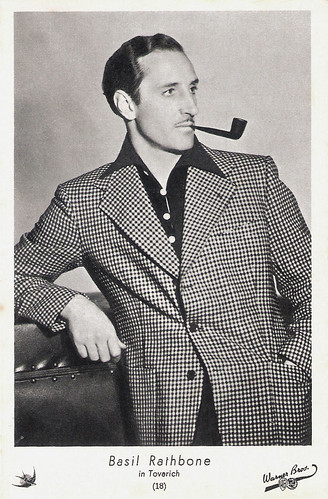
Italian postcard in the series '100 Artisti del Cinema' by Edizione ELAH 'La casa delle caramelle', no. 18. Photo: Warner Bros. Basil Rathbone in Tovarich (Anatole Litvak, 1937).
An unquestionable winner
Anatole Litvak was at his best directing taut, suspenseful crime dramas, such as The Amazing Dr. Clitterhouse (Anatole Litvak, 1938) with Edward G. Robinson and Humphrey Bogart, hailed by Variety as "an unquestionable winner". Also with Warner Brothers, he directed Confessions of a Nazi Spy (Anatole Livak, 1939), starring Edward G. Robinson as an FBI agent who breaks up a Nazi spy ring. It was released at a time of increasing tensions in Europe as the Nazis promoted their expansion. The film was banned in Germany and by its Fascist allies Italy and Spain.
Litvak directed the melodrama The Sisters (Anatole Litvak, 1938) with Bette Davis, and worked with Davis and Boyer again on All This, and Heaven Too (Anatole Livak, 1940) a dramatic love story between a governess and a baron. Again, it became a commercial success, and the film was nominated for an Academy Award as Best Picture. It allowed Litvak to shoot This Above All (Anatole Litvak, 1942), a patriotic love story starring Tyrone Power and Joan Fontaine. He also directed two tough action films starring John Garfield, Castle on the Hudson (Anatole Litvak, 1940) and Out of the Fog (Anatole Litvak, 1941).
Having become an American citizen in 1940, Litvak enlisted in the US Army and collaborated with Frank Capra on the wartime Why We Fight series of documentaries. He was involved in directing The Nazis Strike (Frank Capra, Anatole Litvak, 1942) and Divide and Conquer (Frank Capra, Anatole Litvak, 1942) and The Battle of China (Frank Capra, Anatole Litvak, 1943). He later co-directed War Comes to America (Frank Capra, Anatole Litvak, 1945), the final film in the Why We Fight series. Because of his multilingualism, speaking Russian, German and French, he had a key role as the leader of the photography division that captured the landing of US troops during the D-Day landing in Normandy (Operation Overlord). At the war's end, he left the army with the rank of colonel and returned to Hollywood.
After the war, Litvak made the Film Noir The Long Night (Anatole Litvak, 1947) starring Henry Fonda and the classic thriller Sorry Wrong Number (Anatole Litvak, 1948) with Barbara Stanwyck and Burt Lancaster.
Arguably his best film was the superb psychological drama The Snake Pit (Anatole Litvak, 1948), starring Olivia De Havilland. It was Hollywood's first attempt to seriously examine the treatment of mental illness. Indeed, the film was so influential that it precipitated changes in the American mental health system. Litvak was nominated for an Academy Award as Best Director but lost out to John Huston for The Treasure of the Sierra Madre (John Huston, 1948).

British postcard in the Film Partners Series, London, no. P 251. Photo: Warner. Charles Boyer and Claudette Colbert in Tovarich (Anatole Litvak, 1937).
After the Russian Revolution, a married Russian couple of nobility (Charles Boyer and Claudette Colbert) must take up jobs in Paris to survive. They take positions as butler and housemaid in a wealthy household and, owing to their impeccable breeding and manners, excel in their new jobs. But once they are recognised for the noble couple they are, they must face new - and formidable - responsibilities. Colbert fought with Litvak throughout most of the filming of the screwball comedy Tovarich. Her main problem was with Litvak's cinematographer, Charles Lang. Colbert, famous for demanding that when she be primarily photographed from the left side, didn't feel that Lang was photographing her according to her wishes. She demanded that he be fired. Litvak refused, setting off the battle.

Dutch postcard. Merle Oberon in Till We Meet Again (Edmund Goulding, William K. Howard (uncredited), William Keighley (uncredited), Anatole Litvak (uncredited), 1940).
In Till We Meet Again, dying Joan Ames (Merle Oberon) meets criminal Dan Hardesty (George Brent) on a luxury liner as he is being transported back to America by policeman Steve Burke (Pat O'Brien) to face execution. Joan and Dan fall in love, their fates unbeknownst to one another. Illness caused director Edmund Goulding to be replaced for much of this romantic drama. Anatole Litvak shot approximately 26% of the film, William Keighley 4%, and William K. Howard shot a few retakes. Goulding shot 70% of the picture around bouts of pneumonia.

Italian postcard by B.F.F. Edit., no. 2020. Photo: 20th Century Fox. Tyrone Power in This Above All (Anatole Litvak, 1942).
Litvak's engrossing romantic drama This Above All (Anatole Litvak, 1942) takes place in the early years of World War II, before the United States entered the war. Beautiful and strong-willed Prudence Cathaway (Joan Fontaine) shocks her aristocratic family by enlisting in the WAFs. A fellow WAF sets her up on a blind date with handsome but moody Clive Briggs (Tyrone Power). Prudence learns that Clive is a deserter, but still loves him and senses that he will eventually prove himself a patriot. the film was intended to boost sympathy and support for England, which was already engaged in a desperate battle with Nazi Germany.
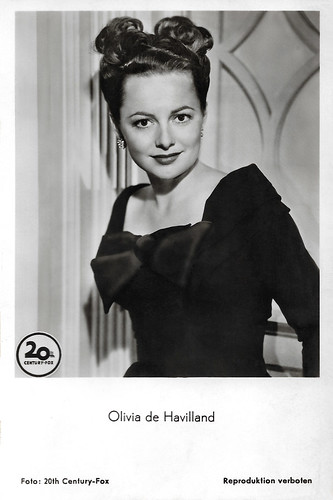
German postcard by F. J. Rüdel, Filmpostkartenverlag, Hamburg-Bergedorf, no. 83. Photo: 20th Century Fox. Olivia de Havilland in The Snake Pit (Anatole Litvak, 1948).
Olivia de Havilland gives a standout performance in The Snake Pit (Anatole Litvak, 1948) a film in line with the interest in psychiatry after World War II. De Havilland plays a troubled, often disoriented woman with unexplained mood swings who winds up in a state mental hospital with no memory of her new husband (Mark Stevens). She becomes a patient of Dr. Kik (Leo Genn) who patiently works with her to try and get to the core of her problem, and to do so, employs several rounds of electroshock therapy. Together they uncover suppressed memories.
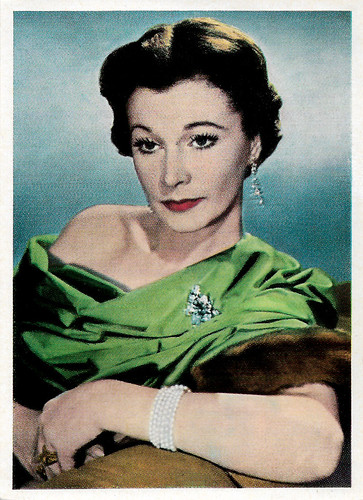
German collectors card in the 'Filmstars von Hollywood bis Tokio' series III. Photo: Vivien Leigh in The Deep Blue Sea (Anatole Litvak, 1955).
Vivien Leigh plays in The Deep Blue Sea a woman unhappy in her passionless marriage. She leaves her husband (Emlyn Williams) for a younger and more ardent lover (Kenneth More). The Deep Blue Sea was based on a successful play by Terrence Rattigan and produced by Alexander Korda in Britain. Litvak cleverly opened Rattigan's play out with flashbacks, many locations (including an air show, Klosters, and the London Embankment) and several big studio sets such as a a huge recreation of London's Soho.
A moody, introspective romantic drama and a suspenseful wartime thriller
In 1949, Anatole Litvak, who had once described Hollywood as a "Mecca", returned to Europe and settled in Paris, working only infrequently. Litvak was especially fond of Paris. He lived there between 1933 and 1936, and again between 1949 and 1974.
In 1951, and from 1955 to 1956, he undertook several projects under contract to 20th Century Fox.
Notable among his later efforts are two contrasting films with Ingrid Bergman. The first one was the lavishly produced Anastasia (Anatole Litvak, 1956) with Yul Brynner, about a woman claiming to be the Romanoff dynasty's last living direct descendant. Bergman won an Oscar for her performance in this film. The second was the moody, introspective romantic drama Goodbye Again (Anatole Litvak, 1961) with Yves Montand and Anthony Perkins, shot on location in Paris.
In stark thematic contrast to these films, he also directed the suspenseful wartime thriller The Night of the Generals (Anatole Litvak, 1967), starring Peter O'Toole. His final film was the psuchological thriller La Dame dans l'auto avec des lunettes et un fusil/The Lady in the Car with Glasses and a Gun (Anatole Litcak, 1970), starring Samantha Eggar and Oliver Reed.
Anatole Litvak died in a hospital in Neuilly, Paris, in December 1974 at the age of 72. He was married to Miriam Hopkins from 1937 till their divorce in 1939. From 1955 till his death, he was married to costume designer Sophie Litvak née Steur. Litvak was awarded a Star on the Hollywood Walk of Fame at 6633 Hollywood Boulevard in Hollywood, California in 1960.
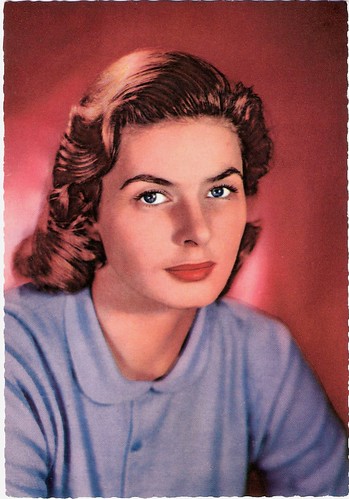
German postcard by ISV, no. A 58. Photo: 20th Century Fox. Publicity still of Ingrid Bergman for Anastasia (Anatole Litvak, 1956).
A trio of unscrupulous Russian exiles (Yul Brynner, Sacha Pitoeff, and Akim Tamiroff) in Paris plot to collect ten million pounds from the Bank of England by grooming Anna, a mysterious, suicidal woman (Ingrid Bergman) to pose as heir to the Russian throne, the Grand Duchess Anastasia. She is so convincing that even the biggest sceptics believe her. At the time of filming Anastasia (Anatole Litvak, 1956), the producers at Fox were not aware that the real Anna Anderson was still alive. After this came to their attention, they flew to her home in Germany and asked permission to use her name. Litvak with his own Russian background gives Anastasia a flavour of authenticity for the main characters and the Russian exile background of the film. The film was shot on location in both Paris and Copenhagen and the camera work is first-rate.

German postcard by ISV, no. A 54. Photo: 20th Century Fox. Publicity still of Yul Brynner for Anastasia (Anatole Litvak, 1956).

Romanian postcard by Casa Filmului Acin, no. 459. Ingrid Bergman and Yves Montand in Goodbye Again (Anatole Litvak, 1961).
Goodbye Again (1961) is an adaptation of Françoise Sagan's bestselling novel 'Aimez-Vous Brahms?'. Ingrid Bergman plays a successful businesswoman, dissatisfied with her current, philandering lover (Yves Montand), who starts an affair with a much younger man (Anthony Perkins). Society does not approve.
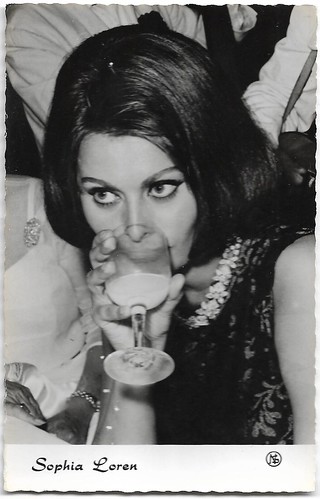
Dutch postcard. NS, 18. On the back, the number 621024 might be the date of printing, so 24 October 1962. Sophia Loren wears the same hairstyle in Le couteau dans la plaie/Five Miles to Midnight (Anatole Livak, 1962).
In Le couteau dans la plaie/Five Miles to Midnight, Italian Lisa Macklin (Sophia Loren) has a fight with her American husband Robert (Anthony Perkins) in a Paris nightclub. He leaves the next day for a business trip and Lisa says she does not want to see him again. She is with newspaperman Alan Stewart that evening when she learns Robert's plane has crashed with no survivors. Waking from sedation after the funeral, Lisa finds Robert in their flat, injured but alive. He now plans to collect the $120,000 insurance he took out at the airport.

Romanian postcard by Casa Filmului Acin, no. 291. Peter O'Toole and Tom Courtenay in The Night of the Generals (Anatole Litvak, 1967).
In 1942, a Polish prostitute and German Agent is murdered in Warsaw in a sadistic way. Major Grau (Omar Sharif), an Agent from German Intelligence who believes in justice, is in charge of the investigation. An eyewitness saw a German General leaving the building after a scream from the victim. A further investigation shows that three Generals do not have any alibi for that night: General Tanz (Peter O'Toole), Major General Klaus Kahlenberge (Donald Pleasence), and General von Seidlitz-Gabler (Charles Gray). The story ends in 1965, in Hamburg, with another, similar crime.
Sources: Il Cinema Ritrovato 2024, I.S. Mowis (IMDb), Mike Rogers (IMDb), Wikipedia and IMDb.
No comments:
Post a Comment